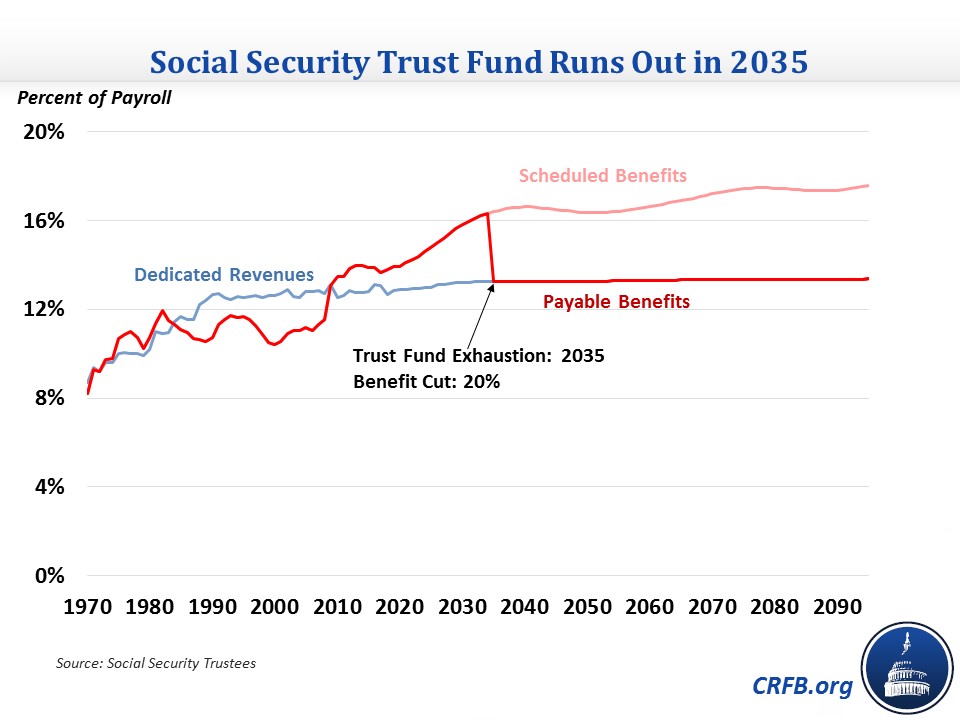Quick Take: Social Security & Medicare Headed For Insolvency in 16 & 7 Years
The Social Security and Medicare Trustees have released their reports on the financial state of their programs. Both reports show the programs need to address their funding imbalances sooner rather than later to prevent across-the-board benefit cuts or abrupt changes in tax or benefit levels. We'll be providing in-depth analyses later today and throughout the week.
The Trustees continue to show that the Social Security program is headed towards insolvency and faces a large and growing shortfall. They project that the Social Security Disability Insurance (SSDI) trust fund will run out in 2052, the Old-Age and Survivors Insurance (OASI) trust fund will be exhausted in 2034, and the theoretical combined Social Security trust funds will run out in 2035. Not surprisingly, the report shows a similar outlook to last year's report. Congress should act promptly to make changes to close the program's shortfall, since 16 years is not a lot of time to enact meaningful and long-lasting reforms.
According to the Trustees, Social Security faces a 75-year shortfall of 2.78 percent of payroll (almost 1 percent of GDP), which will grow to 4.11 percent of payroll by the 75th year. Maintaining solvency for 75 years will require the equivalent of immediately raising payroll taxes by 22 percent (2.7 points), reducing all benefits by about 17 percent, reducing new benefits by 20 percent, or some combination of the three. Maintaining solvency beyond the 75-year window would require the equivalent of ultimately raising the payroll tax by about one-third or reducing scheduled benefits by about one-quarter.

Social Security's deficits are the result of growing spending on benefits and flat revenue. Benefits have already grown from 10.4 percent of payroll in 2000 to 13.9 percent of payroll today and are projected to rise further to 16.6 percent of payroll by 2040 and 17.5 percent by 2093. Revenue will rise slightly, from 12.9 percent of payroll this year to 13.4 percent by 2093.
Compared to the 2018 report, this year's report shows a 75-year shortfall that is about the same (2.78 percent of payroll versus 2.84 percent). The slight reduction of the shortfall can be more than entirely explained by improvements to the finances of the Social Security Disability Insurance fund.
| Change in 75-Year Balance Since Last Year (Percent of Payroll) | |
|---|---|
| Effect on 75-Year Shortfall | |
| 2018 Report's 75-Year Shortfall | -2.84% |
| Legislation/Regulation | 0.00% |
| Change in Valuation Period | -0.05% |
| Demographic Data and Assumptions | +0.06% |
| Economic Data and Assumptions | -0.04% |
| Disability Data and Assumptions | +0.07% |
| Methods and Program Data | +0.01% |
| 2019 Report's 75-Year Shortfall | -2.78% |
Source: Social Security Administration. Note: Numbers do not sum due to rounding.
With regards to Medicare, the Trustees' report estimates that the Hospital Insurance (Part A) trust fund will be exhausted in 2026, the same as projected last year. They project the 75-year shortfall increased from 0.82 percent of payroll last year to 0.91 percent of payroll today.
With regards to Medicare on the whole (including Part B and Part D), the Trustees project total costs will rise from 3.7 percent of GDP this year to 6.0 percent by 2050 and 6.5 percent by 2093.
The latest Social Security and Medicare Trustees' reports provide their annual reminder that both the Medicare and Social Security shortfalls need to be addressed soon. Medicare's trust fund is only 7 years from insolvency, and Social Security's is only 16. Under current law, these programs cannot guarantee full benefits for even current beneficiaries, let alone future ones.
Try your hand at fixing Social Security here or see how old you'll be when the retirement program becomes insolvent, and what you stand to lose.


